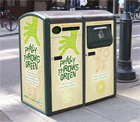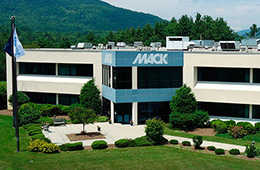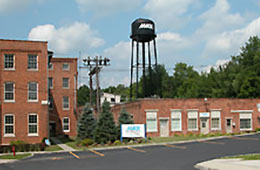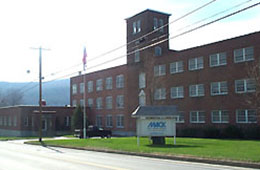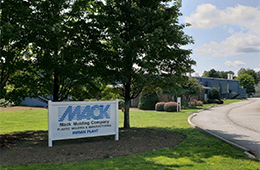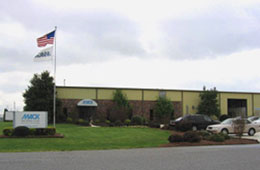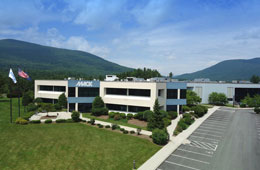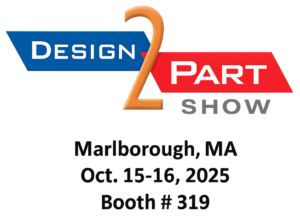CASE STUDIES
Mack Molding
The selection of Mack Molding Consumer Case Studies shown below represents only a few examples of Mack Molding’s services and how they have helped customers resolve challenges and move product to market. It is not intended to provide a comprehensive listing of Mack Molding’s involvement in any industry.
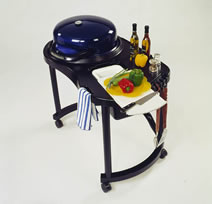 Barbecue Grill Table
Barbecue Grill Table
The Challenge
Optimize a multi-functional, plastic grill table design to:
- Withstand up to 55-pound loads
- Resist high temperatures
- Meet extremely high UV requirements
- Satisfy manufacturability goals
- Assemble easily by the consumer.
The customer came to Mack Molding for both design and manufacturing assistance when it began work on its new outdoor electric grillo. The company wanted a sculpted plastic grill table that could serve several functions:
- Support the electric grill kettle
- Hold a foam insulated cooler for drink/food storage
- Incorporate holders for cooking tools
- Fasten the leg assembly to the grill.
To meet these multiple functions, the overall assembly had to withstand a 10-pound load hanging in the cooler area, a 45-pound load for the grill kettle and its contents, as well as a 55-pound distributed load across the tabletop surface.
The Solution
Mack Molding made recommendations regarding the tool-holder design and handle placement, and helped integrate the cooler concept into the work surface. A 30 percent glass-filled polypropylene resin was chosen, along with injection molding, to provide the most cost-effective material and process solution. To provide additional support, as well as locate and isolate the grill, Mack Molding designed a sheet metal substructure, which fits under the tabletop. Mack Molding also determined the manufacturing detail for the tabletop, including wall thickness, ribbing and mechanical attachments, and designed the cutting board, which covers the cooler.
For more information on this or other Mack Molding Consumer Case Studies, contact sales.south@mackmolding.com.
……………………………………………………………
Stacking Chair
The Challenge
A leading furniture design company headquartered in North Carolina, teamed with an internationally renowned designer to develop a stacking chair that would push the boundaries of originality, technology and craftsmanship. It was originally made only of Scandinavian ash or zebrawood veneer with a variety of painted or natural wood finishes.
While elegant and sleek, the innovative wooden chair is also very complex and expensive to manufacture. The customer wanted to remain 100 percent true to the original design, but at the same time, produce it in a more economical material that would be less expensive to manufacture, expanding its marketability.
The Solution
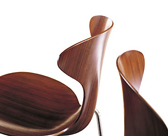
This stacking chair is a perfect example. The first question we had to answer was whether or not Mack Molding could mold the chair using a gas-assisted process. There were cross-sections of the chair that were close to 1.5 inches thick and the customer wanted to maintain the integrity of the original design, which meant producing smooth, very stylish contours on both sides of the chair. Even the gas pins had to be hidden underneath the chair where it mounts to the frame. That meant using multiple gas pins with sequencing to direct the material the way we wanted it to go. Gas-assist was really the only option.
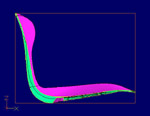
Mack Molding worked closely with Delta Mold, Charlotte, N.C., to build the tool. After some 15 molding trials, the gas-assist process proved successful in reducing stress, maintaining flat and smooth surfaces, reducing both press and part size, and eliminating thick sections of material.
Developing a New Material
While proving out the process, Mack Molding simultaneously worked to sample possible materials. The Company tried everything from polypropylene to nylon to PC/ABS with long glass-fibers, but paintability kept bringing the process back to an amorphous PC/ABS type of material.
Injection Molded Chair
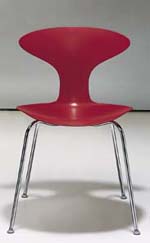
The compound also provides a degree of flex for seating comfort. The material gave the plastic chair flexibility that the wooden chair doesn’t have…it’s not only comfortable, but it has a built-in rocking aspect, a fidget factor. It was an unplanned, unpredictable, positive outcome that has turned into a selling feature for the chair for the customer.
The plastic version sells for roughly half the price of the wooden chair and takes only a fraction of the time to produce.
For more information on this or other Mack Molding Consumer Case Studies, contact sales.south@mackmolding.com.
……………………………………………………………
Oven Handle
The Challenge
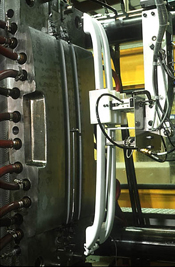
The customer knew gas-assisted injection molding was the answer because it would produce a strong, yet hollow, handle, allowing them to reduce material costs. The two major challenges involved in processing the handle were:
- Aesthetics – difficult to control part after part, especially with a high flex modulus material that is glass-reinforced
- Part weight – critical as a cost component.
The Solution
Mack Molding was selected because it has the technical infrastructure and capability to support gas assist applications, along with having the engineering and manufacturing resources necessary to deliver the project on schedule.
The schedule was a tight one. Mack Molding built molds and produced parts within six weeks. A glass-reinforced VALOX® resin from GE Plastics (now SABIC Innovative Plastics) was chosen for its high strength properties, as well as heat- and chemical-resistance. The handle is gas-assisted injection molded on a 300-ton Toshiba press. With gas-assist technology, Mack Molding achieved a 45 percent weight reduction over a solid part.
Parts submitted for approval were subjected to tests for strength, strip torque, reliability, ship testing, cleanability, soil resistance, and UL approval. The handle not only passed all the tests, they were getting at least double the strength requirement needed, and more than four times the reliability specification.
There were many advantages to using gas-assist on this application. Beyond part consolidation, material reduction and cost savings, the handle has the perfect shape for extracting the most benefit from the gas-assisted injection molding process because the one-dimensional flow path for tube- or rod-shaped parts ensured a good distribution of the gas-channel.
For more information on this or other Mack Molding Consumer Case Studies, contact sales.south@mackmolding.com.
……………………………………………………………
Retail Self-Serve Blender
In this case study, Mack Molding was tasked with assisting a frozen blended beverage company that sells milkshakes, smoothies and frozen cappuccinos to convenience stores, along with a self-serve blender for its patrons to use. The company wanted to launch a new blender that would meet the following four objectives:
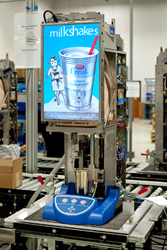
The customer wanted to completely remove the human element from the blender sanitizing process by adding a software-driven, automatic, steam-cleaning process with the pre-wash, steam sanitize and cool-down cycles all managed through the software. To the company’s knowledge, there is no other piece of food equipment used in a retail environment that has an automated cleaning and sanitizing process.
2. Use the new blender to more effectively merchandise its product (the frozen beverage).
Because the customer’s business model is built on recurring revenue from blending shakes and selling frozen beverages, the blender is all about selling more beverage cups. Therefore, to achieve a more commanding presence on the retail counter (where real estate is at a premium), The new blender was designed to be about 12″ taller than the original version, and added a 22″ touch screen LCD on the front to attract attention. Because of its moving, digital content, the screen grabs attention and brings consumers in. It gives first-time users quick instructions, coupled with detailed animation on how to use the blender. And because the blending process takes just under a minute, the customer serves up fun, brand-building content during that time, educating the consumer about the company, its products, nutritional information, and how to contact them.
3. Build in a service alert system that would allow the customer to communicate with the blender remotely.
By adding a 3G modem driven, the customer can now be alerted in real time if there is ever a blender malfunction in the field. The customer can tunnel into the blender to see details about how the blender has been operating, troubleshoot issues, or forecast potential future issues. With the modem, the customer can also push new digital content out to the screens – even customize it by region, store, chain, etc.
4. Improve and simplify aspects of the original blender for the new version.
Because the new blender is a totally new design rather than an update of the older version, the customer wanted to improve and simplify aspects of the blender as appropriate. For example, the mix motor on the new version is now directly in line with the mix motor shaft, eliminating the previous need for a belt-driven system with more parts, costs, etc.
The new blender project supports an overall business strategy of selling as many milkshakes, smoothies and frozen cappuccinos as possible by improving its presence with a larger size and LCD screen to better connect with consumers; and by adding remote communication to diagnose issues and, in some cases, proactively prevent issues from happening, making the blender even more reliable in the field. Attracting more buyers for their retailers and reducing downtime so the blender is up and running at all times, goes directly to the bottom line of both the company and its customers.
Mack Molding’s Involvement
The customer chose Mack Molding as its manufacturing arm in order to get to market quickly with as simplified a supply chain as possible. Already building its original blender, Mack Molding worked through multiple pilot builds and managed numerous engineering changes to speed the product to market.
Mack Molding’s vertical integration satisfied the simplified supply chain requirement, offering:
- Upfront design-for-manufacturability studies for both plastics and metal
- External gas-assist molding for the plastic skins
- Sheet metal fabrication
- Full product assembly
- Supply management that supports both quality and procurement practices for over 400 unique parts from 63 suppliers
- Robust ISO-certified quality management systems
- Distribution.
The customer’s products are now available in over 4,000 retail locations in 47 states across the U.S.
For more information on this or other Mack Molding Consumer Case Studies, contact: salesnorth@mack.com.
……………………………………………………………
Solar Powered Trash Compaction
 Solar-powered Trash Compaction: Cheaper than Collection
Solar-powered Trash Compaction: Cheaper than Collection
Consider the facts:
- This system holds up to five times the volume of ordinary trash receptacles.
- This system can displace four out of five trash pick-ups, dramatically reducing transportation and labor costs.
- This system reduces greenhouse gas by 80%.
- This system can hold 160 gallons of trash.
- This system gets 100% of its energy from the sun and uses less than 5 watt hours/day.
So what is it? The world’s first solar-powered trash compactor. And today, thousands have been sold across the U.S. and in 17 countries around the world.
About the product
Instead of requiring a grid connection, its solar photovoltaic panel turns daylight into electricity, which is stored in a small battery inside the unit. This allows the machine to run at night and during prolonged periods of inclement weather.
Similar in size to an ordinary trash receptacle, its capacity is five times greater (160 gallons) because of compaction. Increased capacity reduces collection trips and can cut fuel use and greenhouse gas emissions by 80 percent. The system can displace four out of five trash pickups, dramatically reducing transportation and labor costs.
When the unit is ready for collection, a wireless monitoring system uses text message technology to signal a web-based database that the unit is full. This allows managers to optimize collection efficiency on a real-time basis.
Optional recycling units can be attached to the compactors to separate trash from recycling. Both units have the same overall design and appearance, but the recycling units are non-compacting with 50-gallon inner bins.
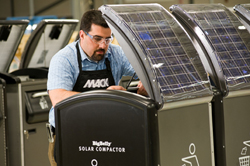 Mack Molding’s Involvement
Mack Molding’s Involvement
Mack Molding molded the solar bubble of high-impact, UV-resistant polycarbonate resin, which must be perfectly clear to expose the solar panel below to the sun. Mack Molding also fabricates the back panel and door out of metal, procures over 150 unique parts, and totally assembles both the compactor and recycler for direct shipment to the client’s customers.
Built to order, the product is highly customizable and can include custom paint; silk-screened logos or artwork; vinyl wraps with custom artwork, stickers, and advertising panels; cigarette snuff plate; bear latch and hot weather handles; two different fronts (paper or can) for the recycling units, and wireless technology.
Philadelphia Case Study
Recently, the city of Philadelphia replaced 700 regular trash receptacles with 500 solar-powered trash compactors and 210 single-stream recycling units. Now, rather than making 17 trips each week to empty 700 receptacles (annual cost: ~$2.3 million), the city now collects only five times per week at an annual operating cost of approximately $720,000 – a 70% savings. Performing 17 collections each week required 33 workers on three shifts; five collections per week under the new program require only nine workers on a single shift. The other workers have been reassigned to other, more productive tasks.
Highlights of the program include:
- Immediate savings: By entering into a three-year financing arrangement, the city has no up-front capital cost and will realize collection cost savings in the first year of approximately $850,000.
- Ongoing savings: Philadelphia will save nearly $13 million in cumulative collection cost savings over the next 10 years, net of the equipment cost.
- Annual operating cost reduction of 70%: Compaction reduces collection demand, which directly reduces operating costs and associated vehicle fuel use and emissions.
For more information on this or other Mack Molding Consumer Case Studies, contact: salesnorth@mack.com.

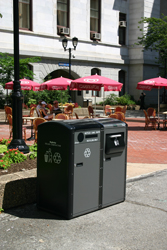 Solar-powered Trash Compaction: Cheaper than Collection
Solar-powered Trash Compaction: Cheaper than Collection